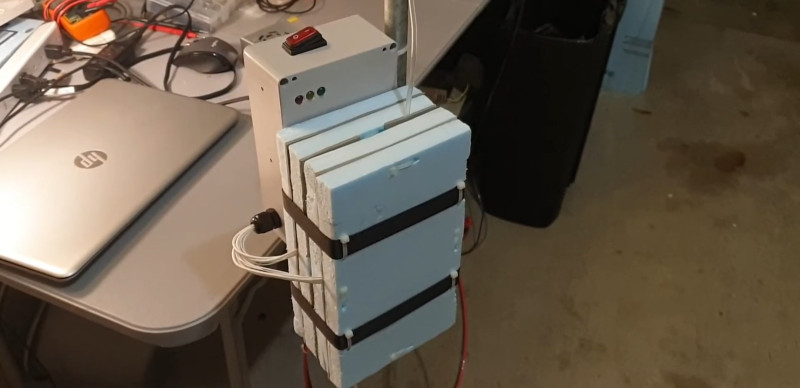Intravenous fluids, or IV fluids, are a vital part of modern life-saving medicine. Depending on the fluids in question, they must often be stored at low temperatures, however, for delivery to a patient, it is beneficial to warm them to approximately 38 degrees to avoid causing hypothermia. To achieve this, an IV fluid warmer is used, but these are not readily available all over the world. To help rectify this shortcoming, [John Opsahl] started the OpenFluidWarmer project.
The goal of the project is to produce a safe, reliable IV fluid warmer that is also easily reproducible. Materials used must be cheap and readily available, and ideally should be easily substitutable where possible to maximise the design’s ability to be built anywhere it’s needed. The name of the project is a nod towards its open design – with the goal of the project to deliver medical equipment to those that don’t have it, there’s little benefit to keeping the design under wraps.
Development continues at a solid pace, with work to optimise the heater performance, firmware, and even the tools required for assembly all documented in the build logs. It’s a project that recalls the scramble earlier this year to create open source ventilators for COVID-19 patients. Ultimately, at the end of the day, it’s about getting medical hardware to where it’s needed most, and we applaud [John]’s efforts in this field! Video after the break.



















Thank the gods someone is making something other than a rubber balloon “ventillator” we have been seeing for the past year or so.
Fluid warmers appear to be simple devices but as John has eluded to in his most recent project log, heating the fluid sufficiently is difficult. It takes lots of surface area to raise the temperature of the fluid.
A commonly used fluid warmer, made by Biegler uses a tubing set something like 3.5 – 4.5m long in contact with the heating element. That plastic tube has some good insulation properties.
I noticed he has been experimenting with immersing the tube in heated water to improve the heat transfer – which was a common method a number of years ago but still requires a reasonable length of tubing to make an effective heat transfer.
The Enflo fluid warmer uses a special giving set containing an aluminum plate which is in direct contact with the IV fluid to maximize heat transfer, but these have had issues with aluminum leaching into some fluids.
Maybe making a heated bag to slip over the bag of IVfluid and heat the whole bag like is done for some home dialysis treatments – it would be slower initially would be one issue.
How about microwaves?
This way the insulating properties of the tube should be of no issue and even help to keep the fluid warm.
Also the power and flow rate can be precisely controlled.
Slalomsk8er,
Interestingly, US FDA has two classifications for fluld/blood warmers. Electromagnetic (radiowaves or microwaves) and non-electromagnetic. From a few searches of the FDA databases, it appears that no electromagnetic fluid/blood warmer solution has ever received FDA approval.
Saabman,
I couldn’t figure out why some IV fluid warmers advertise “no aluminum”. Makes sense now with knowledge of the Enflo fluid warmer issues and recall.
The initial OpenFluidWarmer design is targeting IV fluid flow rates of 20mL/min and below. These are generally considered “low” IV fluid flow rates. Some commercial IV fluid warming systems of similar size can warm fluids from 4°C to 38°C at 100mL/min, but usually require some kind of proprietary, sterile heat exchanger IV tube attachment that gets thrown out after each use. A sterile IV tube attachment to achieve the higher flow rates would push this design above the current cost target.
Interesting comment on what is done for home dialysis. I have considered using a hybrid approach where the IV bag is initially warmed to room temperature in a water bath then IV fluid is warmed to near human body core temperature with the two hot plate OpenFluidWarmer design.
Thanks for sharing.
There’s a reason these products are regulated by the FDA. Products that come into contact with the patient like this are Class 2 devices which represent “moderate to high risk to the patient.” I want to get safe products out there like everyone else, but I wonder how quickly the FDA or the MDR would come down with legal action on doctors attempting to use this in the US or Europe. Sure, this product probably isn’t intended for those markets, but I hope a very, VERY serious approach to risk and patient safety has been taken with development of this device.
Robert,
Absolutely. I have no intention of advocating for clinical use of this design or releasing the assembly and users manuals until the safety and performance of the OpenFluidWarmer device has been proven and documented. I am not looking to take shortcuts here.
This OpenFluidWarmer is meant as a solution in markets where commercial IV fluid warmers are either cost prohibitive or unavailable for sale. As you alluded to, this typically does not include markets in US or Europe. At the same time, it is still a goal of this project to design to as many US FDA requirements as possible. Right now that looks to be generating and compiling all the information needed for a FDA 510(k) submittal.
From what I have seen so far, IV fluid warming solutions in the markets that the OpenFluidWarmer device targets have no proof of performance and have few if any safety features. The OpenFluidWarmer project is the pursuit of a IV fluid warmer design that is affordable, safer, and better performing that existing solutions in these markets.
Thank you for sharing. If you have any interest in providing feedback on the patient and operator risk evaluation of the OpenFluidWarmer device please let me know. Always looking for feedback.